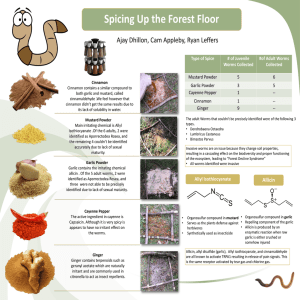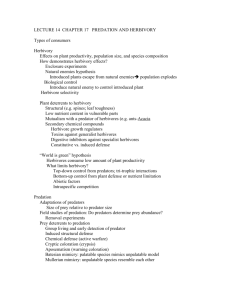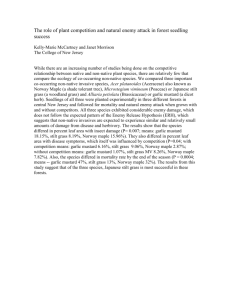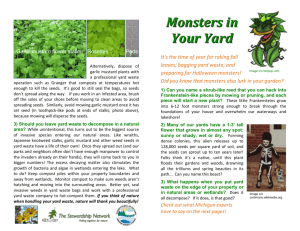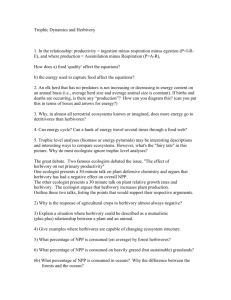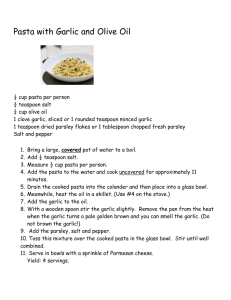Kyle Burns`s report
advertisement
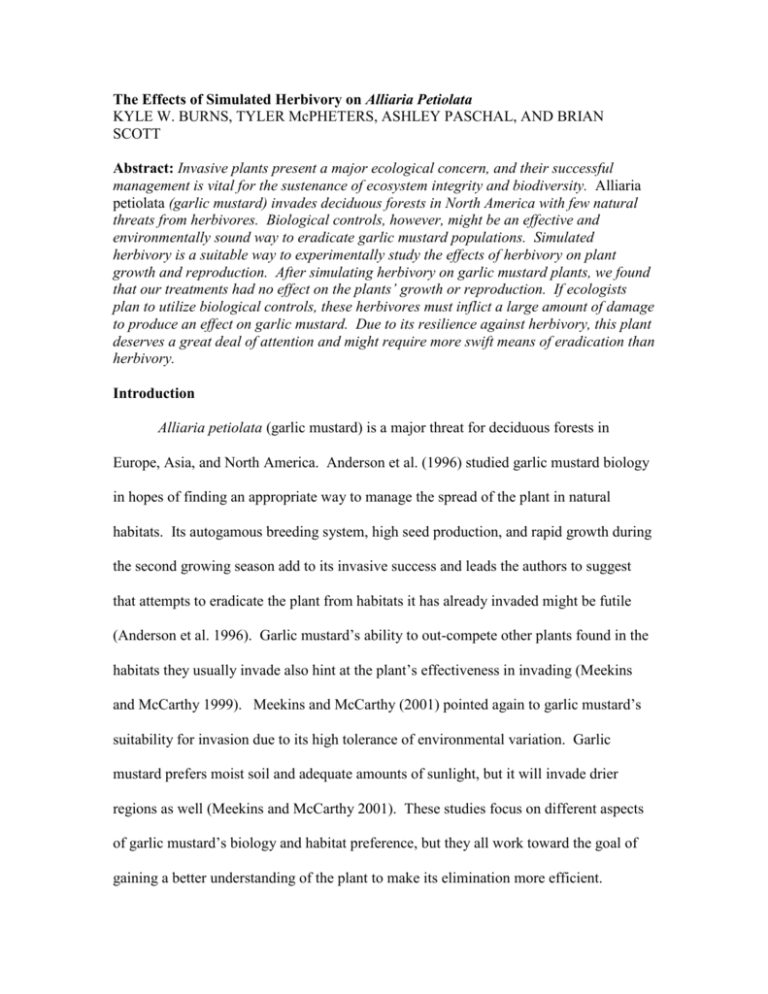
The Effects of Simulated Herbivory on Alliaria Petiolata KYLE W. BURNS, TYLER McPHETERS, ASHLEY PASCHAL, AND BRIAN SCOTT Abstract: Invasive plants present a major ecological concern, and their successful management is vital for the sustenance of ecosystem integrity and biodiversity. Alliaria petiolata (garlic mustard) invades deciduous forests in North America with few natural threats from herbivores. Biological controls, however, might be an effective and environmentally sound way to eradicate garlic mustard populations. Simulated herbivory is a suitable way to experimentally study the effects of herbivory on plant growth and reproduction. After simulating herbivory on garlic mustard plants, we found that our treatments had no effect on the plants’ growth or reproduction. If ecologists plan to utilize biological controls, these herbivores must inflict a large amount of damage to produce an effect on garlic mustard. Due to its resilience against herbivory, this plant deserves a great deal of attention and might require more swift means of eradication than herbivory. Introduction Alliaria petiolata (garlic mustard) is a major threat for deciduous forests in Europe, Asia, and North America. Anderson et al. (1996) studied garlic mustard biology in hopes of finding an appropriate way to manage the spread of the plant in natural habitats. Its autogamous breeding system, high seed production, and rapid growth during the second growing season add to its invasive success and leads the authors to suggest that attempts to eradicate the plant from habitats it has already invaded might be futile (Anderson et al. 1996). Garlic mustard’s ability to out-compete other plants found in the habitats they usually invade also hint at the plant’s effectiveness in invading (Meekins and McCarthy 1999). Meekins and McCarthy (2001) pointed again to garlic mustard’s suitability for invasion due to its high tolerance of environmental variation. Garlic mustard prefers moist soil and adequate amounts of sunlight, but it will invade drier regions as well (Meekins and McCarthy 2001). These studies focus on different aspects of garlic mustard’s biology and habitat preference, but they all work toward the goal of gaining a better understanding of the plant to make its elimination more efficient. 2 With this background knowledge about garlic mustard, it would seem that scientists could easily create a method for wiping out populations, but research on this topic is lacking. Looking at potential treatments for garlic mustard, Blossey et al. (2001) point out that non-biological forms of eradication, such as fires, herbicides, floods, and mowing, might get rid of the plant, but could harm the surrounding natural environment as well. They look, instead, to herbivores as natural and more environmentally sound forms of control. North American garlic mustard faces fewer threats from herbivores than its European relative does, but the introduction of host-specific herbivores to North American populations might help slow the spread of this invasive species (Blossey et al. 2001). Biological controls, however, have the potential to become invasive species themselves when introduced into an environment with plentiful resources, so ecologists must fully consider the usefulness of their introduction (Primack 2002). A useful way to study the effects herbivory has on plant species without the concerns involved with introducing an herbivore is to simulate herbivory in the field or in a lab. When simulating herbivory, one has the advantage of controlling a number of variables, such as the magnitude of damage, the type of damage, differences between treated and untreated plants, and the time needed to inflict the damage (Baldwin 1990). Conscious of these variables, one gains a greater insight as to what type of herbivory most affects the treated plant, an understanding that leads to choosing the most effective biological control agent (Baldwin 1990). One study (Hjältén et al., 1993) showed that birch trees defoliated by simulated herbivory decreased in size along a continuum of treatment strength. Rebek and O’Neil (2005) conducted similar work on garlic mustard and found that between a low and high treatment of simulated herbivory, plants under the 3 high treatment tended to die younger and produce substantially less biomass. Herbivory, it seems, may act as an effective technique for managing garlic mustard populations, but more studies on simulated herbivory will enrich the understanding of how these populations might react to the introduction of natural herbivores. This study examines the effects of simulated herbivory on garlic mustard populations in the DePauw Nature Park. We expected that plants with increased herbivory will show significant signs of damage, with reductions in survival, growth, and reproduction as indicated by differences in aboveground biomass, the number of seeds produced per plant, and the number of flowers per plant. Methods Plot/Site Description We marked forty plots by placing a hula-hoop (≈0.57m2) in dense patches of garlic mustard. To calculate density, we recorded the number of garlic mustard plants per plot. To determine the water content of the soil for each plot, we took soil samples 10 cm unto the ground with a tulip bulb planter. Each sample was immediately massed. We then dried the samples in an oven overnight and massed them while dry, calculating the percent water content by finding the difference between the masses before and after drying and dividing this difference by the wet mass. After collecting the soil samples, we measured the light intensity for each selected plant. We placed the sensor at the central, topmost leaf on each plant and tried to accurately estimate the amount of light received by the plant. Initial Plant Data 4 In each plot, we marked three similarly sized plants as test subjects: one control, one low treatment, and one high treatment plant. For each marked plant, we counted the number of leaves and measured the initial height. Response variables To simulate insect herbivory, we used a standard hole punch to produce a random array of holes in the leaves. Low treatment plants received approximately half the number of holes as high treatment plants, and only half the leaves were punched in each plant receiving treatment. We did not punch the control plants. A week later, we noted if each plant showed signs of flowering. On our final day of data collection, we measured the final height of each marked plant and counted the number of flowers per plant. We then collected the plants, dried them in an oven overnight, and massed them to find the aboveground biomass for each plant. Statistical analysis We compiled our descriptive data for each plot and ran one-way ANOVAs testing for the differences among the treatments in the means of the initial variables (total leaves, initial height, and light interception) and in the means of the response variables (number of flowers, biomass, and final height). Next, we ran bivariate correlations among the variables for the entire data set and for each treatment separately. Results The ANOVA tests showed that the plants did not significantly vary with respect to the controlled and tested variables (total leaves, initial height, light meter reading, number of flowers, final height, and biomass). The simulated herbivory treatments had no significant effect on final height (p>.05) (Figure 1a), the number of flowers (p>.05) 5 (Figure 1b), and aboveground biomass (p>.05) (Figure 1c). Positive correlations were found between initial height and density, total number of leaves, number of flowers, final height, and biomass, and between final height and number of flowers and biomass (Table 1). Discussion With no significant ANOVA tests, it appears that the plants did not significantly vary before treatment application with respect to initial height and total number of leaves. The treatments did not produce detectable effects on the plants’ growth or reproduction, as evidenced by the uniformity of the number of flowers, final height, and biomass of plants under all treatments. The correlations between the initial and response variables are expected. For example, the initial number of leaves correlates with the initial height, indicating only that larger plants have more leaves. Other obvious correlations existed between final height and biomass, biomass and number of flowers, and initial height and number of flowers. All of these correlations point to the fact that plants that grow more tend to have greater mass and more flowers than smaller plants. The correlation between plant height and density was significant but lower than expected since increased density usually has a strong effect on plant height, as plants grow taller in competition for sunlight. Despite a visual perception that we inflicted a large amount of damage on the garlic mustard, we suspect that our herbivory treatment design was ineffective in curbing the garlic mustard’s growth and reproduction. The amount of leaf matter we removed might not have been enough to produce a reaction from the plants. When Bossdorf et al. (2004) conducted a similar experiment, they cut away 75% of the leaf surface area in two 6 different treatments. Even with this extensive removal, the treated plants showed only a 19% reduction in fitness compared to the controls. Considering the small impact of this large amount of herbivory, our treatments seem miniscule. Visibly, the damage seemed immense, but it did not phase the plants. We might also consider the part of the plant that receives the treatment as vital for the efficacy of simulated herbivory. Rebek and O’Neil (2005) had success when simulating herbivory on flower shoots instead of leaf matter. Plants receiving their high treatment showed signs of decreased growth and reproduction. Simply punching holes in the leaves, as conducted in our study, may not reflect the most vulnerable parts of the plant. This lack of measurable effects, however, does not indicate that our study failed in adding to our understanding of garlic mustard. Our study should lend immediacy to the problem of this invasive plant that remains unaffected by the removal of large amount of leaf area. The resilience of garlic mustard exhibited in this study is a concern for the future of the DePauw Nature Park. With few threats from North American herbivores (Blossey et al. 2001), garlic mustard populations are likely to continue expanding without the introduction of some kind of control. Should ecologists attempt to eradicate garlic mustard by introducing herbivores, they must only consider those animals or insects that will inflict an extensive amount of damage on the plants. For our study site, attempts to remove garlic mustard in such a way might prove fruitless. Other management techniques, such as cutting down or pulling out the plants, might directly hinder the plants from spreading prolifically in the absence of threatening herbivores. Focusing on 7 new, small patches of garlic mustard, like the one around the quarry, might be a wiser use of resources than trying to combat the large, established patches of the Rail Trail forest. This project relates directly to the goals of conservation biology, to investigate human impact on the environment and to develop practical approaches to prevent diversity loss, maintain present variation, and restore lost diversity and ecosystem functions. Humans have introduced most invasive species, and garlic mustard is no exception. By studying how to fight the spread of garlic mustard, we are working to figure out how to reverse the damage imposed on the environment by humans. Since invasive species tend to eliminate native species, thus causing a decline in biodiversity, examining how herbivory might work as a biological control serves as progress toward preventing the future loss of, the maintenance of present, and the restoration of past diversity to the invaded habitats. This study also addresses conservation biology’s complimentary ethical principles. If biodiversity should be preserved, then the elimination of garlic mustard is an appropriate step toward maintaining and restoring native diversity to natural habitats. Garlic mustard invasions might lead to the untimely extinction of populations and species or the diminution of ecological complexity. By out-competing other plants for resources, garlic mustard prevents the evolution of new species. Garlic mustard’s potential to interfere with ecosystem development and evolution conflicts with conservation biology’s ethical principles, and work such as this that gives insight as to how we might rid the world of this detrimental plant serves the best interests of conservationists. Acknowledgement Thanks to Dana Dudle for her time, effort, and enthusiasm. 8 Literature Cited Anderson, R.C., S.S. Dhillion, and T.M. Kelley. 1996. Aspects of the ecology of an invasive plant, garlic mustard (Alliaria petiolata), in central Illinois. Restoration Ecology 4: 181-191. Baldwin, I.T. 1990. Herbivory simulations in ecological research. Trends in Ecology and Evolution 5: 91-93. Blossey, B., V. Nuzzo, H. Hinz, E. Gerber. 2001. Developing biological control of Alliaria petiolata (M. Bieb.) Cavara and Grande (garlic mustard). Natural Areas Journal 21: 357-367. Bossdorf, O., S. Schroder, D. Prati, and H. Auge. 2004. Palatability and tolerance to simulated herbivory in native and introduced populations of Alliaria petiolata (Brassicaceae). American Journal of Botany 91 (6):856-862. Hjältén, J., K. Danell, and L. Ericson. 1993. Effects of simulated herbivory on intraspecific competition on the compensatory ability of birches. Ecology 74 1136-1142. Meekins, J.F., and B.C. McCarthy. 1999. Competitive ability of Alliaria petiolata (garlic mustard, Brassicaceae), an invasive, nonindigenous forest herb. International Journal of Plant Sciences 160: 743-752. Meekins, J.F., and B.C. McCarthy. 2001. Effect of environmental variation on the invasive success of a nonindigenous forest herb. Ecological Applications 11: 1336-1347. Primack, R.B. 2002. Essentials of conservation biology. Sinauer Associates, Sunderland, Massachusetts, USA. Rebek, K.A., and R.J. O’Neil. 2005. Impact of simulated herbivory on Alliaria petiolata survival, growth and reproduction. Biological Control 34:283-289. 9 Figure 1 a. Treatment Effect on Final Height Final Height (cm) 140 120 Control 100 Low Treatment 80 High Treatment 60 40 20 0 b. Treatment Effect on Number of Flowers Number of Flowers 120 100 Control 80 Q uickTim e™ and a decom pr essor ar e needed t o see t his pict ur e. 60 Low Treatment High Treatment 40 20 0 c. Treatment Effect on Biomass 10 Biomass (g) 8 Control 6 4 Q uickTim e™ and a decom pr essor ar e needed t o see t his pict ur e. Low Treatment High Treatment 2 0 Figure 1. Differences in treatment effect on a.) final height (F=.503), b.) number of flowers (F=.229), and c.) aboveground biomass (F=2.861). 10 Table 1 Table 1. Pearson Correlations between all (control and tested) variables for control, low treatment, and high treatment plants.
